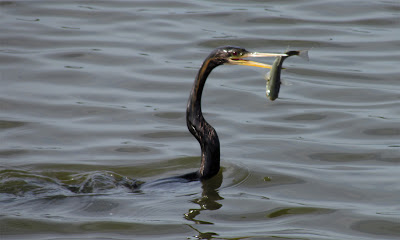Like I said before, the entire reason James and I headed down to Huntington Beach State Park
That morning, I watched an American Alligator idling in the water next to some large wooden scaffolding. Perhaps he was eyeing the Snowy Egret that would dart in and out of the rungs, every once in a while picking off a fish or two from the water’s surface. But the egret was skittish, and when the gator got too close it flew to the top row of the scaffolding. Luckily for me, this was about my eye level, and I enjoyed a great look at a common bird.
Without any indication, a huge white thing flew in and scared the Snowy Egret off its perch. And suddenly I was staring face to face with an enormous Wood Stork. I’m not sure if I’ve made it clear how awesome I find Wood Storks, but I think they’re pretty much the coolest bird ever. Just to get the chance to see a whole flock of them was almost enough to ease the sting of missing the spoonbills, and yet here I stood not five feet from one, enjoying every crook and cranny of its knobby head.
Immediately, I phoned James on his cell as he was off watching Common Gallinules and Painted Buntings. This was one of the coolest things I’d ever seen; he had to be there to photograph it! Alas, by the time James showed up, the Wood Stork abandoned his perch in favor of a little mid-morning hunting. To be fair, the bird was still right off the causeway and our views were amazing. But they’ll never match a Wood Stork that I could’ve reached out and touched if I wanted to.
If you watch Wood Storks hunt for a while, you’ll notice some idiosyncrasies about them. For one, most of the time they just stand there with their bills open, hoping something will swim through slowly enough that they can clap them shut. For another, they’ll often walk around with one wing outstretched, presumably shading the water so a hapless fish will take shelter underneath. It looks prehistoric when they do it, like they’re honest to God dinosaurs feeding in a herd during the late Cretaceous. Of course, being birds, they are in fact honest to God dinosaurs, but that’s a story for another time.
At that point, we had a choice – stick around in South Carolina , watching birds we’ve already seen, or make a bee-line for Twin Lakes North Carolina , where the very Roseate Spoonbills we were looking for had been roosting for the last couple weeks. Not that we needed any help in the decision, but a couple Triangle-area birders let us know that the spoonbills had been seen earlier that morning. In little more than an hour (thanks to some poor directions from the internets), James and I found ourselves looking across the lakes for any signs of birds roosting in trees. And just our luck, they were nowhere to be found.
Disappointed, we tried one last pass at the lakes, and on the way back we noticed a couple white birds perched in a tall pine. They were far off, but they were definitely Wood Storks, and the Roseate Spoonbills were reported to be associating with a Wood Stork flock. As we scoped the far end of the lake, none of the birds turned pink enough for us to pick them out from a distance. I even began to convince myself that a far-off Snowy Egret looked like a spoonbill! I was that delusional. Then, something flew out from the far tree and into the water next to an old flagpole.
 |
| There's gotta be one in there somewhere! |
I could barely see it with my naked eye, but the view through the scope confirmed it – Roseate Spoonbills, two of them! They fed alongside the storks and egrets like they had no idea that two birders had traveled through hell and high water to watch them. But at this distance, the views weren’t nearly satisfying enough. We drove down a side road, and sure enough there was an empty lot right next to where the spoonbills were hanging out. We raced down the hill, braving poison ivy and stinging nettles until we were right on top of the birds.
I took a second to myself. Sitting there, watching a pair of birds that I’ve wanted to see since I was a kid. The ridiculous looking bills, the muted pink just starting to grow in. I almost couldn’t believe it. Yet there they were, oblivious to my ecstatic state as birds are wont to do. Fearing we may be trespassing, we headed off before five minutes were up. But those five minutes were all I needed to fully enjoy one hell of a lifer.
On the way back to the car I noticed a Broadhead Skink sauntering through the leaf litter. I could have caught it were I fast enough, but I was still in a dreamlike state from seeing those two awesome birds. I don’t think there’s any life bird that I’ve wanted to see as badly as these spoonbills, and now that I’ve seen them, I honestly feel a little aimless. Like the sole purpose of my birding career to this point had been to find Roseate Spoonbills. I guess I’ll just have to find some other bird to hunt down so passionately, but I’m not sure what that bird will be. I suppose Snowy Owls are cool. Yeah. I choose Snowy Owls.





































